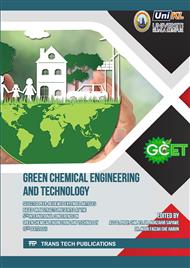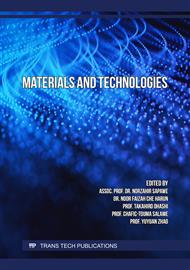[1]
A. G. Georgiadis, N. D. Charisiou, and M. A. Goula, Removal of hydrogen sulfide from various industrial gases: A review of the most promising adsorbing materials,, Catalysts, vol. 10, no. 5, (2020).
DOI: 10.3390/catal10050521
Google Scholar
[2]
N. N. Zulkefli, M. S. Masdar, W. N. Roslam Wan Isahak, J. M. Jahim, S. A. Md Rejab, and C. C. Lye, Removal of hydrogen sulfide from a biogas mimic by using impregnated activated carbon adsorbent,, PLoS One, vol. 14, no. 2, (2019).
DOI: 10.1371/journal.pone.0211713
Google Scholar
[3]
N. N. Zulkefli, M. S. Masdar, J. Jahim, and E. H. Majlan, Overview of H2S Removal Technologies from Biogas Production,, Int. J. Appl. Eng. Res., vol. 11, no. 20, p.12–14, (2016).
Google Scholar
[4]
D. Wibowo, Y. Hui, A. P. J. Middelberg, and C. X. Zhao, Interfacial engineering for silica nanocapsules,, Adv. Colloid Interface Sci., vol. 236, p.83–100, (2016).
DOI: 10.1016/j.cis.2016.08.001
Google Scholar
[5]
A. R. Sujan, S. H. Pang, G. Zhu, C. W. Jones, and R. P. Lively, Direct CO 2 Capture from Air using Poly(ethylenimine)-Loaded Polymer/Silica Fiber Sorbents,, ACS Sustain. Chem. Eng., vol. 7, no. 5, p.5264–5273, (2019).
DOI: 10.1021/acssuschemeng.8b06203
Google Scholar
[6]
Y. Li, F. Song, Y. Guo, L. Cheng, and Q. Chen, Multifunctional Amine Mesoporous Silica Spheres Modified with Multiple Amine as Carriers for Drug Release,, J. Nanomater., vol. 2018, (2018).
DOI: 10.1155/2018/1726438
Google Scholar
[7]
J. Bin Zakaria, S. R. Abd Shukor, and K. Abdul Razak, Effect of Surfactant, Solvent and Stirring Rate on the Synthesis of Silica Nanoparticles Entrapped Rifampicin,, J. Chem. Eng. Ind. Biotechnol., vol. 5, no. 2, p.36–47, (2020).
DOI: 10.15282/jceib.v5i2.3677
Google Scholar
[8]
H. Moribe, Y. Kitayama, T. Suzuki, and M. Okubo, Effect of stirring rate on particle formation in emulsifier-free, organotellurium-mediated living radical emulsion polymerization (emulsion TERP) of styrene,, Polym. J., vol. 44, no. 3, p.205–210, (2012).
DOI: 10.1038/pj.2011.115
Google Scholar
[9]
E. Vilarrasa-Garcia et al., CO2 adsorption on amine modified mesoporous silicas: Effect of the progressive disorder of the honeycomb arrangement,, Microporous Mesoporous Mater., vol. 209, p.172–183, (2015).
DOI: 10.1016/j.micromeso.2014.08.032
Google Scholar
[10]
C. Chen, J. Kim, and W. S. Ahn, CO2capture by amine-functionalized nanoporous materials: A review,, Korean J. Chem. Eng., vol. 31, no. 11, p.1919–1934, (2014).
DOI: 10.1007/s11814-014-0257-2
Google Scholar
[11]
F. Maia, J. Tedim, A. D. Lisenkov, A. N. Salak, M. L. Zheludkevich, and M. G. S. Ferreira, Silica nanocontainers for active corrosion protection,, Nanoscale, vol. 4, p.1287–1298, (2012).
DOI: 10.1039/c2nr11536k
Google Scholar
[12]
Á. A. Beltrán-Osuna and J. E. Perilla, Colloidal and spherical mesoporous silica particles: synthesis and new technologies for delivery applications,, J. Sol-Gel Sci. Technol., vol. 77, no. 2, p.480–496, (2016).
DOI: 10.1007/s10971-015-3874-2
Google Scholar
[13]
S. Meoto, N. Kent, M. M. Nigra, and M. O. Coppens, Effect of stirring rate on the morphology of FDU-12 mesoporous silica particles,, Microporous Mesoporous Mater., vol. 249, p.61–66, (2017).
DOI: 10.1016/j.micromeso.2017.04.045
Google Scholar
[14]
N. Juárez-Serrano, J. Asensio, I. Blasco, M. Beltrán, and A. Marcilla, Effect of time, temperature and stirring rate used in the first step of the synthesis of sba-15 on its application as reductor of tars in tobacco smoke,, Catalysts, vol. 11, no. 3, p.1–19, (2021).
DOI: 10.3390/catal11030375
Google Scholar
[15]
T. Yokoi et al., Mechanism of formation of uniform-sized silica nanospheres catalyzed by basic amino acids,, Chem. Mater., vol. 21, no. 15, p.3719–3729, (2009).
DOI: 10.1021/cm900993b
Google Scholar
[16]
H. I. Lee, J. H. Kim, G. D. Stucky, Y. Shi, C. Pak, and J. M. Kim, Morphology-selective synthesis of mesoporous SBA-15 particles over micrometer, submicrometer and nanometer scales,, J. Mater. Chem., vol. 20, no. 39, p.8483–8487, (2010).
DOI: 10.1039/c0jm00820f
Google Scholar
[17]
L. Bois, A. Bonhommé, A. Ribes, B. Pais, G. Raffin, and F. Tessier, Functionalized silica for heavy metal ions adsorption,, Colloids Surfaces A Physicochem. Eng. Asp., vol. 221, no. 1–3, p.221–230, (2003).
DOI: 10.1016/s0927-7757(03)00138-9
Google Scholar
[18]
K. Choi et al., Chromium removal from aqueous solution by a PEI-silica nanocomposite,, Sci. Rep., vol. 8, no. 1, (2018).
Google Scholar
[19]
Y. K. Lu and X. P. Yan, An Imprinted Organic-Inorganic Hybrid Sorbent for Selective Separation of Cadmium from Aqueous Solution,, Anal. Chem., vol. 76, no. 2, p.453–457, (2004).
DOI: 10.1021/ac0347718
Google Scholar



